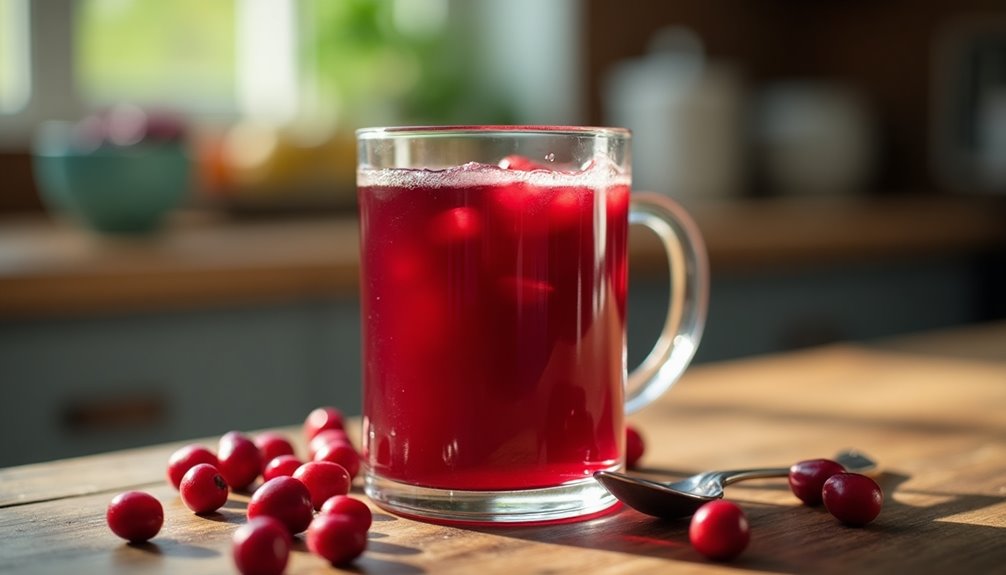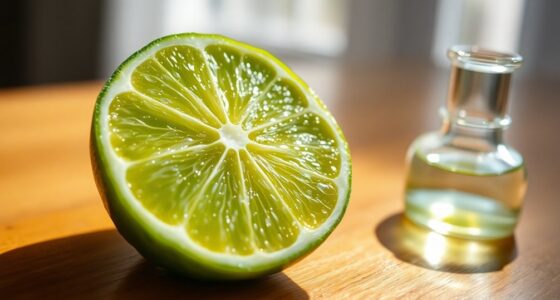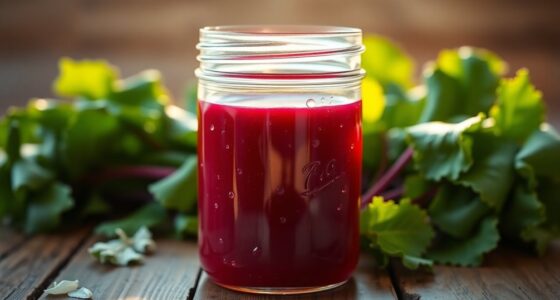To get out cranberry juice, act quickly! Blot the stain with a clean white cloth to absorb excess liquid—don't rub it in. Rinse the fabric under cold water, then treat the stain with a liquid laundry detergent or enzyme stain remover. If the stain's dried, soak it in cold water for 30 minutes and use color-safe oxygen bleach. Always air dry after treatment; using a dryer can set the stain. You'll find even more helpful tips ahead!
Key Takeaways
- Act quickly by blotting the cranberry juice stain with a clean white cloth to absorb excess liquid.
- Rinse the stained area under cold water for non-colorfast fabrics, or hot water for colorfast items to loosen the stain.
- For dried stains, soak the fabric in cold water for 30 minutes before applying an oxygen-based bleach safe for colors.
- For upholstery or carpets, mix ⅔ cup rubbing alcohol with 2 tablespoons vinegar and gently sponge the stain without saturating.
- Always air dry treated items to avoid setting the stain; repeat the treatment if necessary.

When cranberry juice spills happen, you need to act fast to prevent stubborn stains. The key here is to tackle the stain immediately, so grab a clean white cloth and start blotting the area. This helps absorb the excess liquid and stops the stain from spreading. Don't rub it; just gently blot to lift the cranberry juice stains without pushing them deeper into the fabric. The quicker you respond, the better your chances of completely removing the stain.
Next, it's time to rinse the stained fabric. If the material is non-colorfast, rinse it under cold water. For colorfast items, use hot water. This step is crucial for loosening the stain before you treat it with a liquid laundry detergent or a liquid enzyme stain remover. Apply the stain remover directly to the cranberry juice stain, following the instructions provided by the manufacturer. Let it sit for a few minutes to penetrate the fabric effectively.
If you're dealing with dried cranberry stains, don't worry. You can still salvage the fabric. First, soak it in cold water for about 30 minutes to help break down the stain. After soaking, follow up with oxygen-based bleach that's safe for colors. Make sure to carefully read the instructions to avoid damaging your fabric. Applying this method can significantly reduce the appearance of stubborn stains.
For upholstered furniture or carpets, the approach changes slightly. Mix a solution of ⅔ cup rubbing alcohol and 2 tablespoons of vinegar. Using a clean cloth, gently sponge the stain with this mixture, ensuring that you don't saturate the fabric. Too much liquid can create a bigger mess, so be careful. This technique can effectively lift cranberry juice stains from these surfaces without causing further damage.
After you've treated the stain, always air dry the item. This is important because using a dryer can set any remaining stain, making it even more challenging to remove. If the stain persists after air drying, you may need to repeat the treatment process. Sometimes stubborn stains require a little persistence and multiple attempts.
In terms of fabric care, always check the labels on your clothing or upholstery to ensure that you're using the right method for that specific material. Different fabrics react differently to treatments, so being informed can save you a lot of trouble in the long run.
Frequently Asked Questions
Do Cranberry Juice Stains Come Out?
Yes, cranberry juice stains can come out if you act quickly.
Rinse the stain with cold water for non-colorfast fabrics, or use hot water for colorfast ones.
Apply an enzyme-based stain remover or a heavy-duty detergent to the affected area.
If the stain's dried, you might need to use oxygen-based bleach, following the instructions carefully.
Always air dry your items afterward, as heat can set the stain permanently.
Is Cranberry Juice Hard to Get Out of Clothes?
Did you know that cranberry juice stains can be up to 80% more stubborn than other fruit juices?
Yes, it can be tough to get out of clothes if you don't act quickly. The longer you wait, the harder it gets to remove those pesky stains.
You'll want to use cold water for fresh stains and consider enzyme-based stain removers for the best results.
Don't let it linger—treat it as soon as possible!
How Do You Get Cranberry Juice Out of a Bed?
To get cranberry juice out of a bed, start by blotting the stain immediately with a clean, dry cloth.
You'll want to absorb as much liquid as possible without rubbing.
Next, mix ⅔ cup rubbing alcohol with 2 tablespoons white vinegar and apply it to the stain using a sponge.
Let it sit for about 10 minutes, then gently dab with a damp cloth.
Rinse with cold water and blot dry with another clean cloth.
Does Oxiclean Get Out Cranberry Juice?
Did you know that 50% of people experience a stain from food or drink at least once a week?
If you're wondering whether Oxiclean gets out cranberry juice, the answer's a resounding yes! Its oxygen-based bleach formula effectively targets tough stains without harming your fabrics.
Just soak the stained item in a solution for 30 minutes before washing, and for dried stains, apply a paste directly to the area.
Always air dry before checking for remaining discoloration!
Conclusion
So, you've spilled cranberry juice and think it's hopeless? Don't fret! With the right approach, you can tackle those stains effectively. Remember, acting quickly is key, and using simple household items can make a world of difference. By following the steps outlined, you'll not only restore your fabric but also gain confidence in handling future spills. Don't let one accident ruin your day—take charge and show those stains who's boss! You've got this!
Cindy thoroughly researches juicing trends, techniques, and recipes to provide readers with practical advice and inspiration. Her writing style is accessible, engaging, and designed to make complex concepts easy to understand. Cindy’s dedication to promoting the advantages of juicing shines through her work, empowering readers to make positive changes in their lives through the simple act of juicing.











